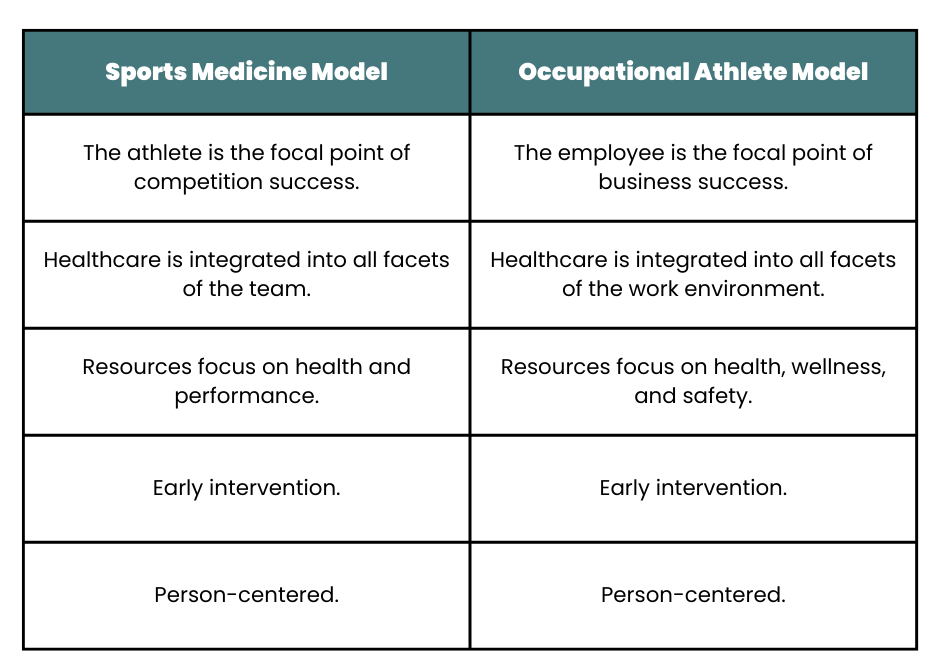During Captive Resources’ December Risk Control Webinar, Mike VanAmberg, who has an athletic training background and is now vice president of operations for Work-Fit, suggested that employers adopt a sports medicine mindset to implement truly injury-preventive health and safety programs. Read on to learn how you can facilitate better employee health outcomes at your company with this creative approach.
VanAmberg kicked off the webinar by contrasting two types of employer health and safety programs. He raised the audience’s awareness of the differences with the words typically associated with each.
VanAmberg explained that employees covered by traditional disease care-focused programs lack a health support system, and their perceptions of their employers tend to turn distrustful. Eventually, the relationship between the two parties can become adversarial — a lose-lose scenario. To prevent that scenario, he explained how to transition the focus of a program from disease care to healthcare.
VanAmberg’s approach to helping companies make this transition is to show them how to incorporate athletic training principles into their programs. Stressing words and phrases again, he revealed how the audience can incorporate Sports Medicine Model concepts into an “Occupational Athlete Model” to smoothly transition their programs from disease care-focused to healthcare-focused.

VanAmberg said many companies have successfully transitioned their health and safety programs from a disease care focus to a healthcare focus by implementing the Occupational Athlete Model since the 1980s. He pointed out that implementation is not prohibitively expensive and feasible for any employer. He also shared several proven concepts and programs employers can use to establish this model.
He recommended that employers make employees’ health and safety not only task- and job-specific but also personal with safety education. Make education transcend the classroom, e.g., convey that employees’ on-the-job injuries can adversely affect their off-the-job activities. Stress the importance of self-care off the job, e.g., sleep deprivation impairs the necessary recuperation of body and mind for the next shift. Use effective safety education such as safety talks, pamphlets, and placards.
This is a significant area of opportunity in preventive safety, according to VanAmberg, who added that although work conditioning requires some upfront investment, it also has a return. Often, this consists of dynamic (movement-focused) personal or group warmups, pre- and post-shift stretching, and micro-break activities, e.g., opposite movements to alleviate repetitive motion stress.
VanAmberg noted that human performance coaching focuses on body mechanics, postures, work patterns, etc. A significant advantage of this program is that it makes employees part of the solution.
He stressed that early intervention does not mean denying employees necessary injury care. Instead, it emphasizes treating early-onset musculoskeletal symptoms when they’re more manageable. Employers can set up self-care stations (“pit stops”) as part of effective intervention.
Implementing a preventive Occupational Athlete Model makes achieving a win-win relationship for both employers and employees a realistic goal, according to VanAmberg.
Using OSHA’s Safety Pays Program calculator, he estimated the direct cost of a typical strain injury at more than $32,000. Also, the typical indirect cost to the business is more than $67,000. According to VanAmberg, preventing about three recordable injuries could pay for a full-time injury prevention/early intervention specialist for a full year.
VanAmberg added that the Occupational Athlete Model has yielded higher employee performance and productivity. It can create a supportive workplace culture and decrease employee turnover, making the company an employer of choice. Loyal employees often become sales ambassadors, which can drive higher sales. Most importantly, he said, implementing a preventive health and safety program that inspires employees is the right thing to do.
This presentation was part of Captive Resources’ Risk Control Webinar Series — regular installments of webinars to educate the group captive members we work with on topics like workplace safety, organizational leadership, and company performance. The thoughts and opinions expressed in these webinars are those of the presenters and do not necessarily reflect Captive Resources’ positions on any of the above topics.